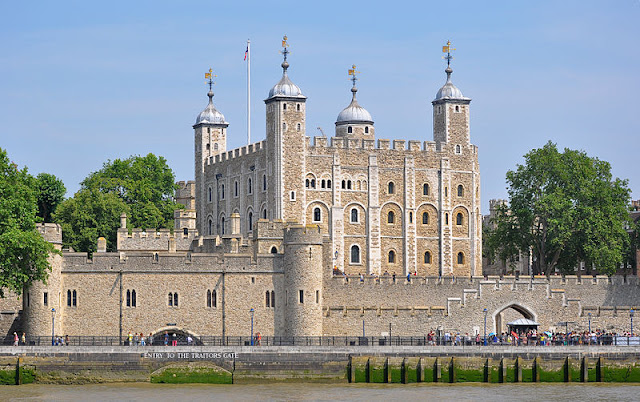Full in the midst of a mighty pile arose,
Where iron-grated gates their strength oppose
To each invading step, and, strong and steep.
The battled walls arose, the fosse sunk deep.
Slow round the fortress rolled the sluggish stream,
And high in the middle air the warder's turrets gleam.
-Anonymous
"The history of the Tower of London is so closely
bound with the history of England," wrote a turn of the 20th century author.
Since the 11th century, the Tower of London has overlooked the city of London
and is remains one of the most enduring and recognizable landmarks of the
British capital, attracting hundreds of thousands of visitors every year to
marvel at this cultural gem.
The Tower of London has captured the imagination of
poets, artists, and writers through centuries. In the book A Survey of London, John Stow wrote in 1598:
“This tower is a citadel to defend or command the city; a royal palace for assemblies or treaties; a prison of state for the most dangerous offenders; the only place of coinage for all England at this time; the armoury for warlike provision; the treasury of the ornaments and jewels of the crown; and general conserver of the most records of the kind’s courts of justice at Westminster.”
Throughout its long history the Tower has served as a
royal palace and fortress, prison and place of execution, an arsenal, royal
mint, menagerie, and jewel house. Today, London’s great royal fortress is home to
some of the most potent symbols of British history: the Yeoman Warders, Ravens
and crown jewels.
A visit to the Tower leads one to many interesting
buildings and collections to explore and wealth of British royal history to
discover.
What to see in the Tower of London?
The Crown Jewels
Home to the world-famous British Crown Jewels since the
beginning of the 14th entury. Still used by the Queen and her family today, the
Crown Jewels are an essential part any visit to the Tower. Entering the Tower through
the Middle and Byward towers reveal an impression of how the Tower was
protected against potential attack. Walking along Water Lane leads to the Traitors’
Gate where many famous prisoners entered the Tower of London for the last time.
Other attractions include the Cradle Tower and Henry III’s Watergate.
The White Tower
Construction commenced at the reign of William the
Conqueror (1066-1087). The White Tower marks the start of the Tower of London’s
history as both a palace and a fortress. Magnificent new displays of arms and
armour from the collection of the Royal Armouries are exhibited here.
The Wall Walk
The Tower of London is surrounded by a series of massive
defensive walls.
The Tower of London was a former royal residence for the
kings and queens of England as well as being a fortress. These rooms are shown
as they might have appeared in the reign of Edward I (1272-1307). An exhibition
about how the buildings were restored can be found inside.
The army has been involved with the Tower of London ever
since its creation and today the Royal Regiment of Fusiliers, organized in 1685
to protect the royal guns within the Tower, open their museum to the public. On
display are many fascinating exhibits which illustrate the history of the
Regiment.
Some of the Tower’s most famous and important prisoners
were held in the buildings around Tower Green including Sir Walter Ralegh who
was imprisoned in the Bloody Tower for 13 years. In front of the Chapel Royal
of St. Peter ad Vincula seven famous prisoners were beheaded.
The Yeoman Warders
Yeoman Warders (often called Beefeaters’) have been at the
Tower of London since the 14th century. They combine their traditional ceremonial role with
that of tourist guide.
Legend has it that Charles II was told that if the Ravens
left the Tower, the monarchy would fall; so he ensured that a limited number
would be kept here permanently. The story of the Ravens is told next to their
lodgings.










.png)





1 Comments
Wonderful blog. Great ideas and fun read.
ReplyDeleterickshaw